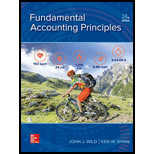
Concept Introduction:
Moreover, the balance sheet is a complex display of this equation.
The explanation from a through j that best describes the transactions 1 through 5.
Explanation of Solution
Any purchase or sale by an accounting equity has an equal effect on both sides of the equation, or has offsetting effects on the same side of the equation. Keeping this
The above equation tells that the company only has$40,000 cash which is financed from the capital. And this situation is best explained by the Option d, stating the owner invested $40,000 cash in the business.
From the above equation, we can interpret that the Company had $40,000 cash, out of which it spent $2,000 and is left with $38,000 cash in hand. From those $2,000 cash, it bought office supplies worth $3,000 by borrowing $1,000. This equation is best described in the Option e, stating that the company purchased office supplies for $3,000 by paying $2,000 cash and putting $1,000 on credit.
The above equation explains that the company spent $8,000 cash more to buy office furniture, which in turn reduced the cash in hand to $30,000. And this is best explained by the Option a, stating that the company purchased office furniture for $8,000 cash.
The equation mentioned above shows that the company made credit sales for $6,000, which increased the accounts receivable on the asset side and revenues on the equity side. This is better explained by the Option f, which states that the company billed a customer $6,000 for services provided.
In this equation, the cash in hand increased by $1,000 with $1,000 increase in revenue, which implies that the company sold services of $1,000 in cash. This equation is best explained in the Option h, which states that the company provided services for $1,000 cash.
Want to see more full solutions like this?
Chapter 1 Solutions
Fundamental Accounting Principles
- Meridian Business Group obtained an office building, parking lot, and furniture in a lump-sum purchase for $520,000. An appraisal set the value of the office building at $312,000, the parking lot at $208,000, and the furniture at $104,000. At what amount should Meridian Business Group record each new asset on its books?arrow_forwardI am searching for the right answer to this financial accounting question using proper techniques.arrow_forwardRebecca Corp. has a current ratio of 4.8 and an acid-test ratio of 4.3. The company's current assets consist of cash, marketable securities, accounts receivable, and inventories. Inventory equals $18,000. Rebecca Corp.'s current liabilities must be: a) $24,000 b) $36,000 c) $90,000 d) $120,000arrow_forward
- A new production equipment with a purchase price of $125,000, freight costs of $12,500, setup costs of $8,500, and testing fees of $4,000, would have a cost basis of what?arrow_forwardPlease explain the solution to this general accounting problem using the correct accounting principles.arrow_forwardNonearrow_forward

 AccountingAccountingISBN:9781337272094Author:WARREN, Carl S., Reeve, James M., Duchac, Jonathan E.Publisher:Cengage Learning,
AccountingAccountingISBN:9781337272094Author:WARREN, Carl S., Reeve, James M., Duchac, Jonathan E.Publisher:Cengage Learning, Accounting Information SystemsAccountingISBN:9781337619202Author:Hall, James A.Publisher:Cengage Learning,
Accounting Information SystemsAccountingISBN:9781337619202Author:Hall, James A.Publisher:Cengage Learning, Horngren's Cost Accounting: A Managerial Emphasis...AccountingISBN:9780134475585Author:Srikant M. Datar, Madhav V. RajanPublisher:PEARSON
Horngren's Cost Accounting: A Managerial Emphasis...AccountingISBN:9780134475585Author:Srikant M. Datar, Madhav V. RajanPublisher:PEARSON Intermediate AccountingAccountingISBN:9781259722660Author:J. David Spiceland, Mark W. Nelson, Wayne M ThomasPublisher:McGraw-Hill Education
Intermediate AccountingAccountingISBN:9781259722660Author:J. David Spiceland, Mark W. Nelson, Wayne M ThomasPublisher:McGraw-Hill Education Financial and Managerial AccountingAccountingISBN:9781259726705Author:John J Wild, Ken W. Shaw, Barbara Chiappetta Fundamental Accounting PrinciplesPublisher:McGraw-Hill Education
Financial and Managerial AccountingAccountingISBN:9781259726705Author:John J Wild, Ken W. Shaw, Barbara Chiappetta Fundamental Accounting PrinciplesPublisher:McGraw-Hill Education





